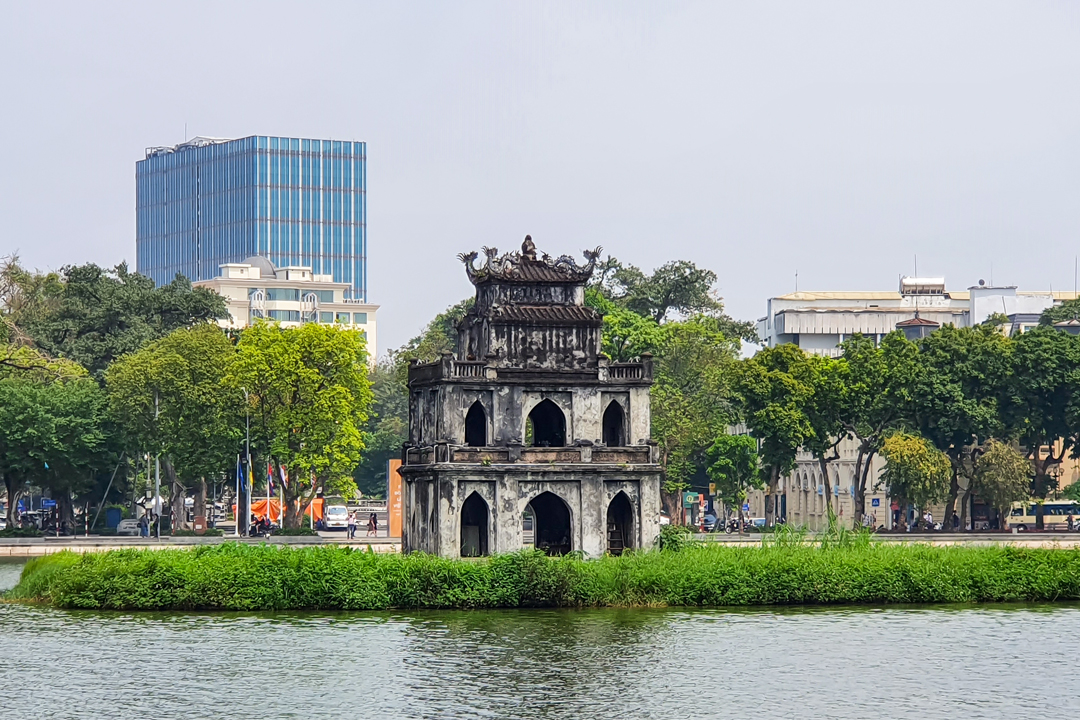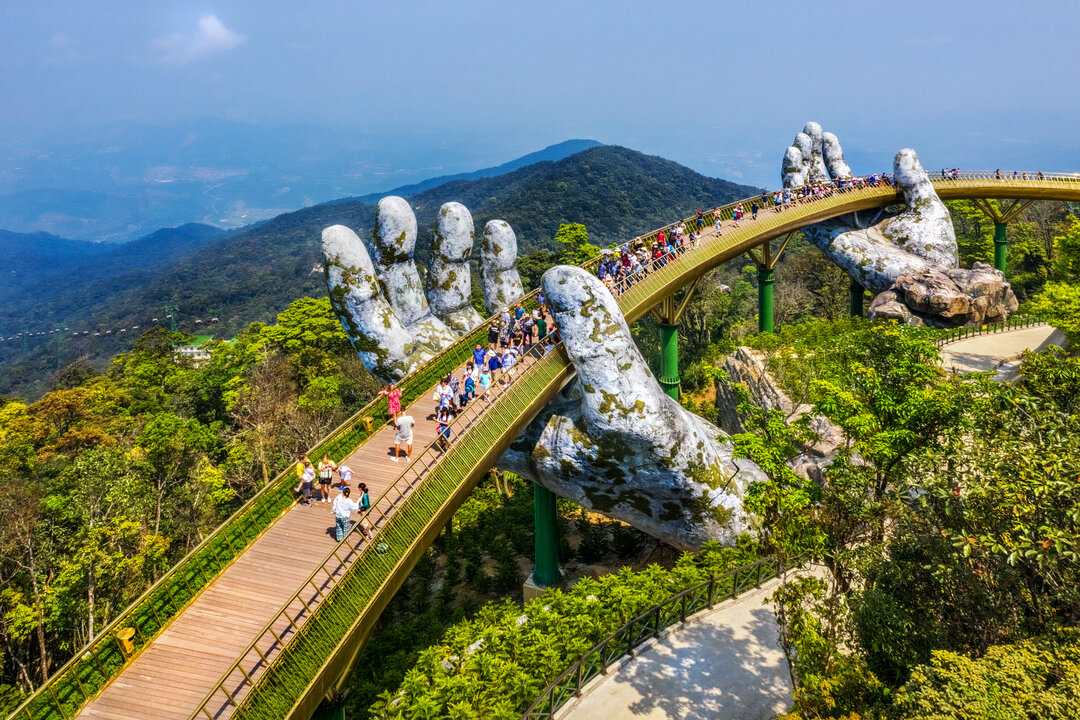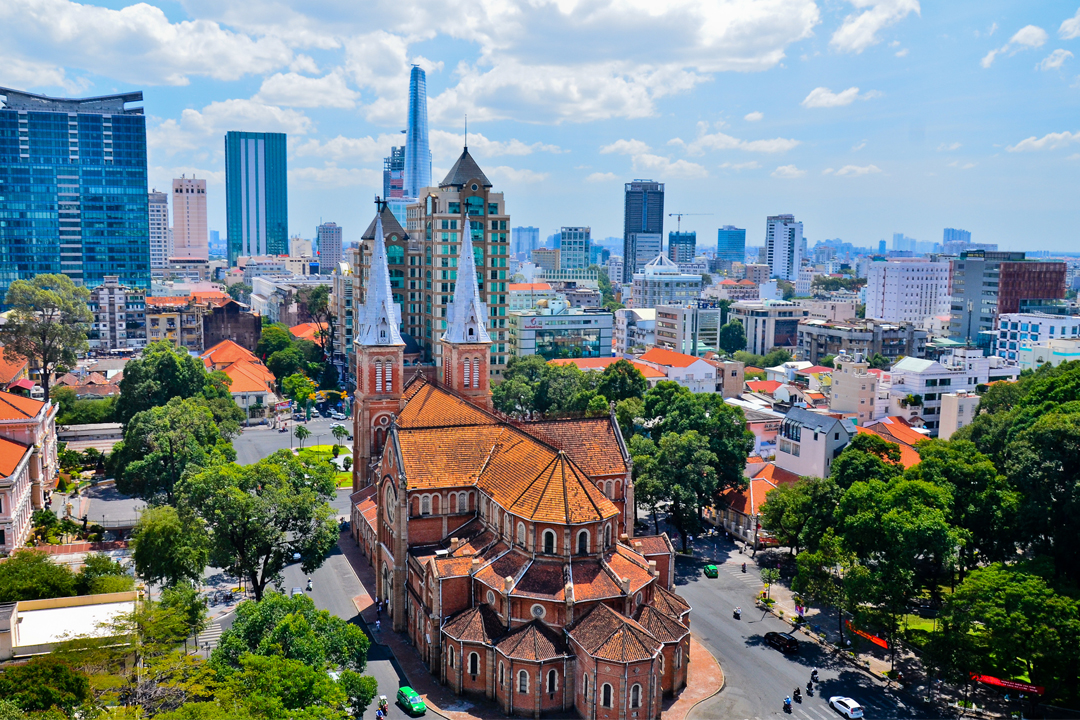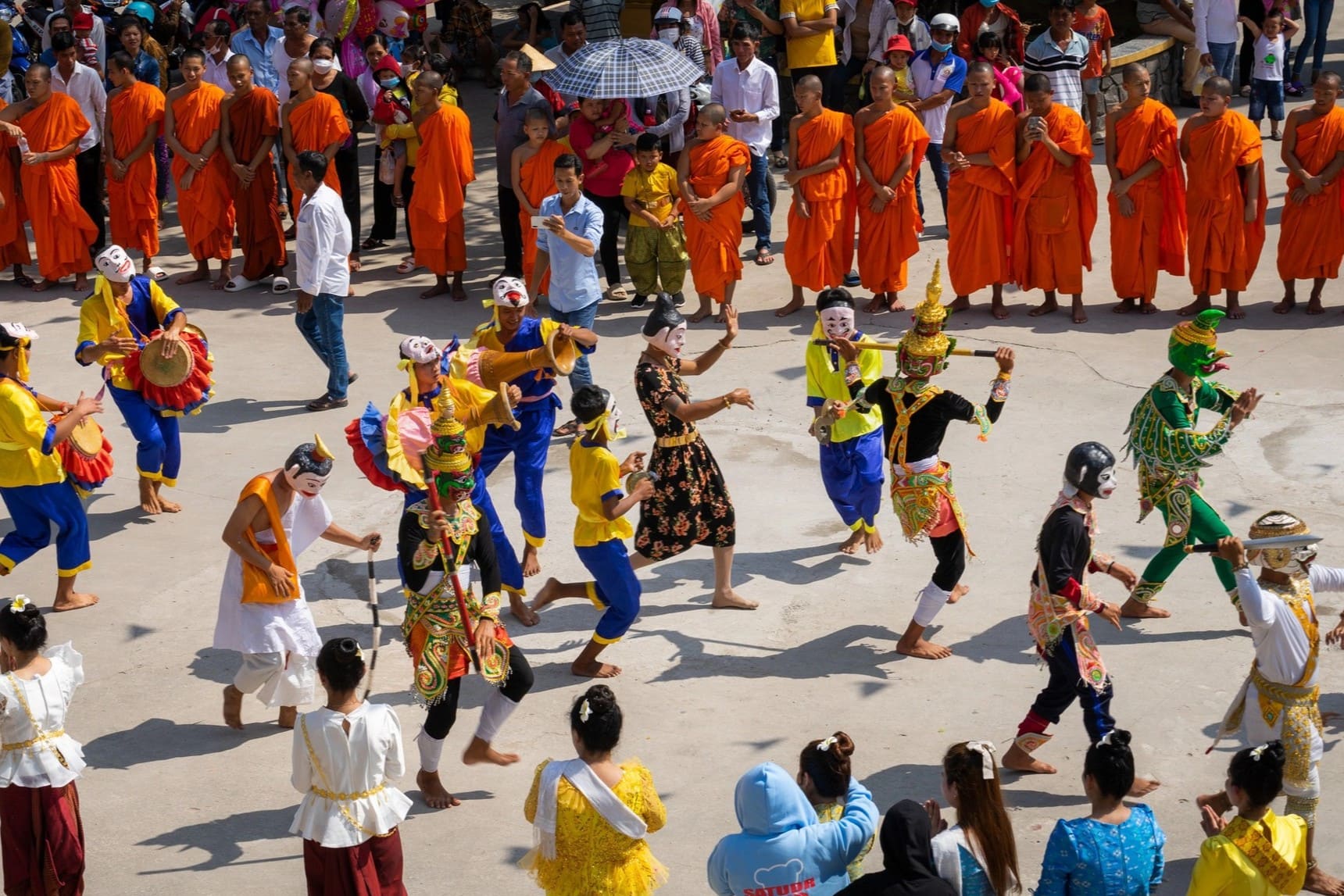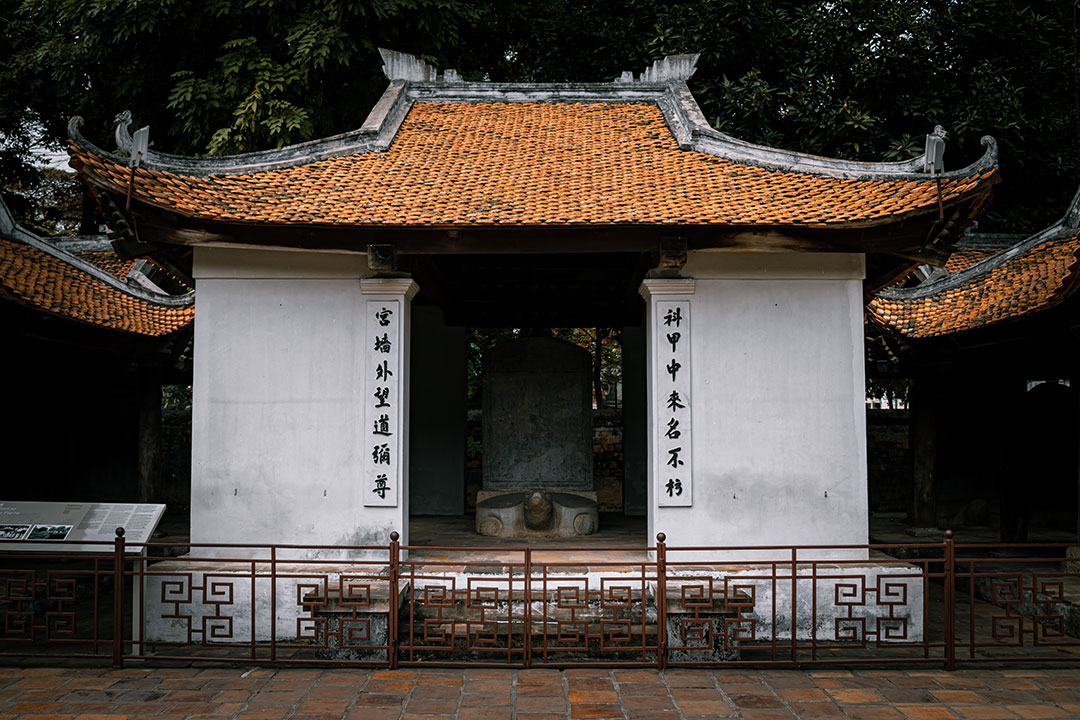Temple Of Literature: History, Things To See & Travel Guide
The Temple of Literature (Van Mieu - Quoc Tu Giam) is one of Hanoi’s most iconic landmarks, celebrating Vietnam’s deep respect for learning and Confucian traditions. Founded in 1070, it was both a temple to Confucius and the nation’s first university, where generations of scholars shaped the country’s culture and history. Today, visitors can explore its peaceful courtyards, admire the Khue Van Pavilion, and discover the stone steles honoring academic excellence. With GTrip’s guide, you’ll find practical tips and deeper insights to make the most of your visit to this timeless symbol of knowledge.
Overview of Temple of Literature
Location: 58 Quoc Tu Giam Street, Van Mieu - Quoc Tu Giam Ward (formerly Dong Da District, Hanoi)
Founded in 1070 by Emperor Ly Thanh Tong, the Temple of Literature began as a Confucian sanctuary and soon became Vietnam’s first university. It stands as a symbol of the nation’s devotion to education, culture, and Confucian values.
Today, this historical monument captivates visitors with its five courtyards, ancient architecture, and 82 UNESCO-recognized stone steles honoring generations of scholars. Iconic features like the Khue Van Pavilion and Thien Quang Well highlight its cultural significance. Appearing on the 100,000 VND banknote, the Temple remains a revered icon of Vietnam’s intellectual heritage and a must-visit destination in Hanoi.
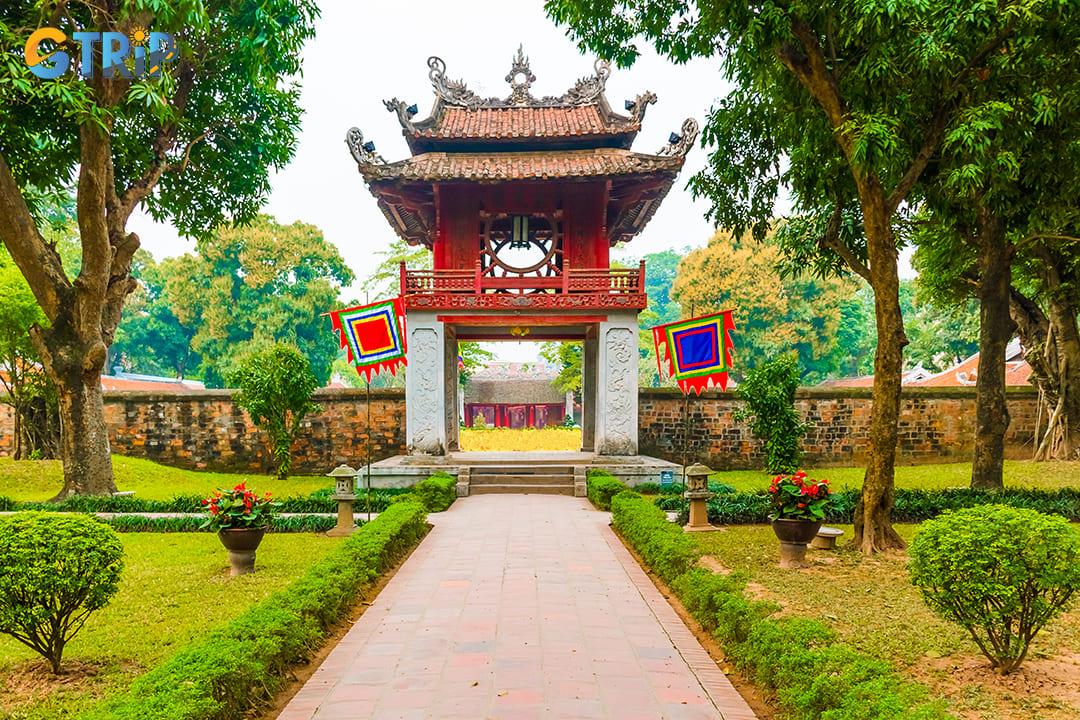
Temple of Literature symbolizes Vietnam's dedication to education, culture, and Confucian values
Opening hours & Entrance fees of the Temple of Literature
To plan a visit to the Temple of Literature effectively, understanding its operating hours and entrance fees is essential. As a historic and cultural landmark, the temple’s accessibility varies slightly based on the season, while its entrance fees cater to both local people and international travelers.
Opening hours
The Temple of Literature is open daily from 8:00 AM - 5:00 PM. It is advisable to arrive early, especially during weekends and public holidays. The temple tends to attract both tourists and local people, including students participating in traditional prayer ceremonies before exams.
Entrance fees
Entrance fees to the Temple of Literature are affordable, making it accessible to a wide range of visitors, from students to international tourists:
- Adults: 70,000 VND ($1.17)
- Vietnamese students (with valid student ID): 35,000 VND ($0.59)
- Vietnamese seniors (60+ years old, with ID) and individuals with severe disabilities: 35,000 VND ($0.59)
- Children under 16: Free of charge
- Automatic audio guide (foreign languages): 100,000 VND ($1.67)
To qualify for the student discount, you must present a valid student ID card at the ticket counter. Discounts are primarily intended for Vietnamese students, but international students may inquire at the entrance regarding eligibility.
Where to buy tickets:
- Ticket counter: Located near the main gate (Van Mieu Gate), ensuring easy access for all people.
- Online platforms: Although primarily aimed at local audiences, some official tourism websites and travel agencies may offer tickets as part of guided tours.
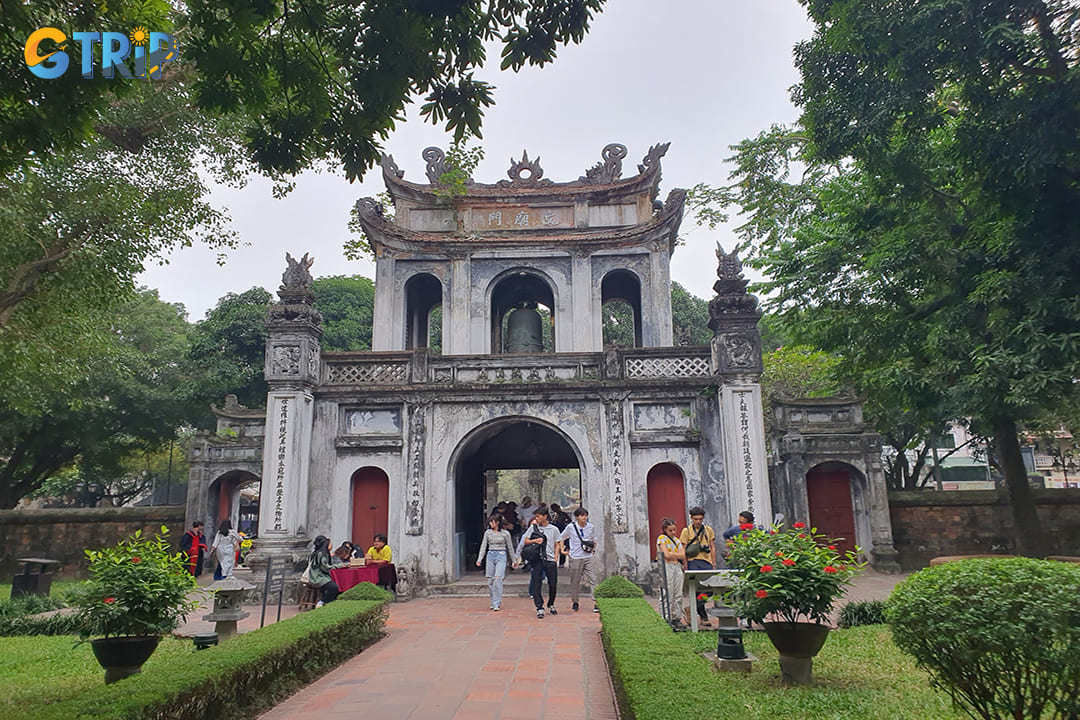
It is advisable to arrive early, especially during weekends and public holidays
How to get to the Temple of Literature?
The Temple of Literature is a central and easily accessible landmark in the city. You can choose from several convenient transportation options to reach this cultural and historical site. Below is a comprehensive guide on how to reach the Temple of Literature efficiently.
1. By taxi or ride-hailing apps
Taxi services
- Traditional taxis: Major taxi companies in Hanoi like Mai Linh Taxi and G7 Taxi are reliable. They have visible meters to avoid overcharging.
- Estimated cost: 80,000 - 120,000 VND (~$3.50 - 5.00) from Hoan Kiem Lake, depending on traffic.
- Duration: 15-20 minutes, considering Hanoi's traffic conditions.
Ride-hailing apps
- Grab and Be: These are popular and widely used in Hanoi. They provide motorbike and car options, with clear pricing displayed before booking.
- Xanh SM: A rising competitor to Grab and Be, offering similar services with electric cars and motorbikes.
- Estimated cost: 40,000 - 80,000 VND (approx. $1.50 - $3.50) for a motorbike; 70,000 - 100,000 VND (approx. $3 - $4.50) for a car.
- Advantages: Avoids language barriers and potential scams. Payments can be made via cash or the app.
Tips:
- Always check the license plate and driver details before getting in.
- Request drivers to drop you off at Van Mieu Gate, the main entrance.
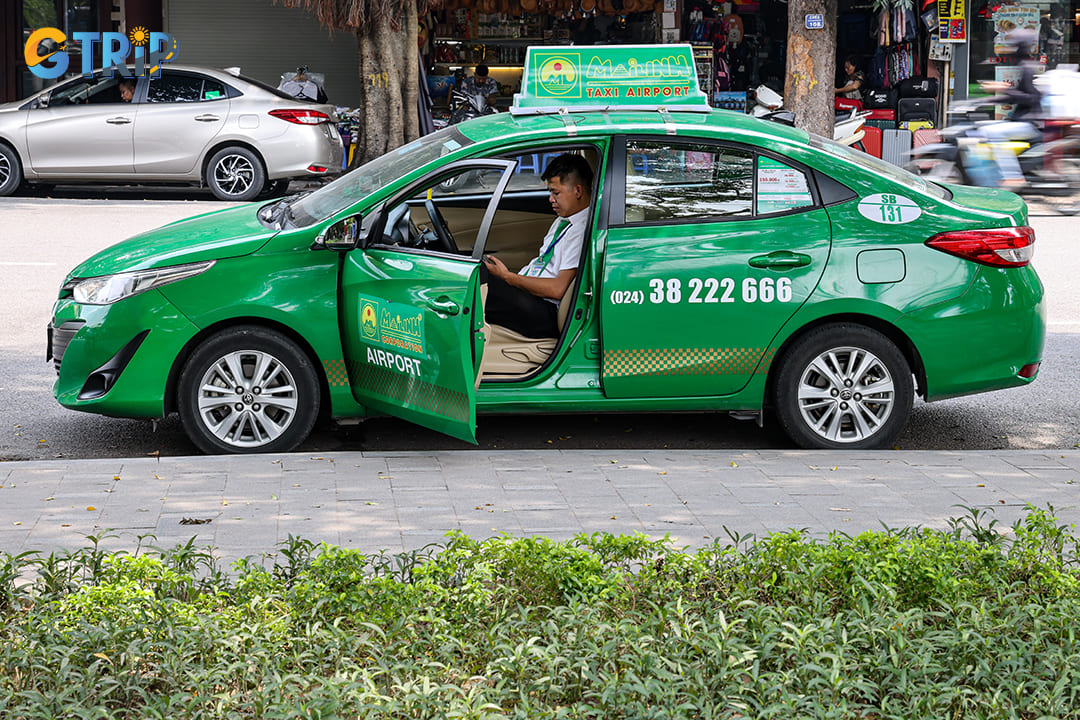
Major taxi companies in Hanoi like Mai Linh Taxi and G7 Taxi are reliable
2. By public bus
Hanoi's public bus system is affordable and relatively comprehensive. Key routes passing near the Temple of Literature include:
- Bus 2: Goes from Hoan Kiem Lake to Thuy Khue
- Bus 23: Connects Long Bien to Ngoc Khanh
- Bus 38: Runs between Giap Bat Bus Station and My Dinh Stadium, passing through central areas
- Bus 25: Travels from Giap Bat Station to former Cau Giay District, with a stop near the temple
Bus information:
- Fare: 7,000 VND (approx. $0.30) per ride
- Operating Hours: 5:00 AM to 10:00 PM
- Payment: Usually pay by cash only. Prepare small notes as buses sometimes don't give change
Tips:
- Use the Timbuyt.vn website or app to check real-time routes and schedules
- Be cautious of pickpockets on crowded buses
- Announce your destination ("Van Mieu") clearly or show it in writing to the conductor
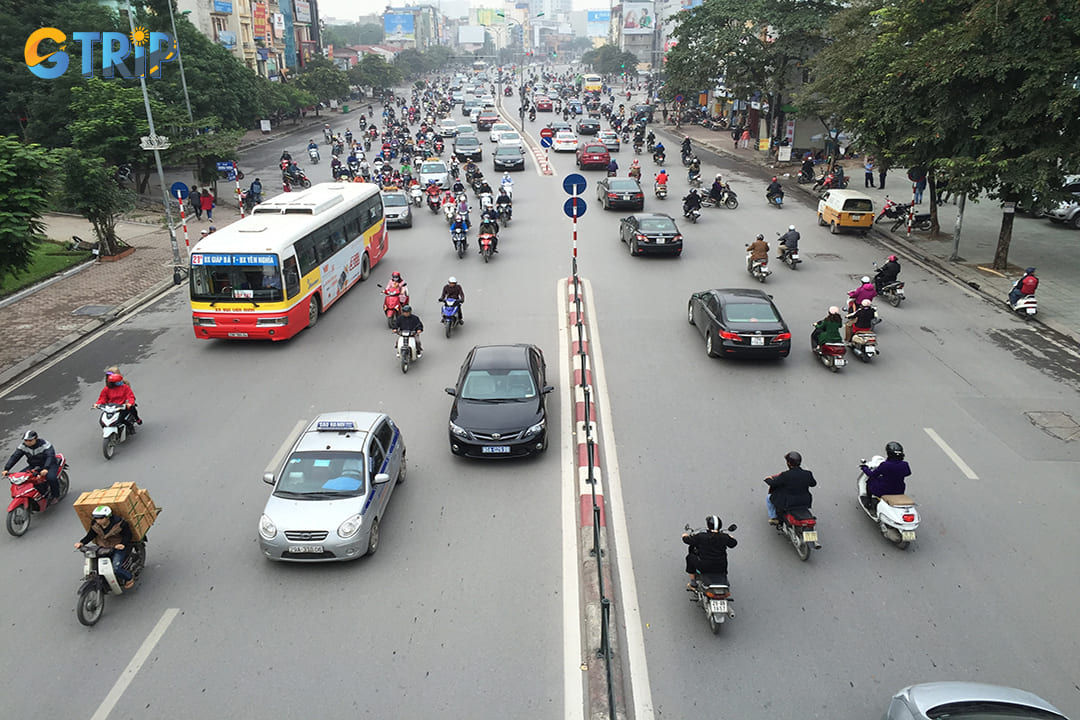
Hanoi's public bus system is affordable and relatively comprehensive
3. By walking from Hoan Kiem Lake
If you're already exploring Hanoi's Old Quarter or Hoan Kiem Lake, walking to the Temple of Literature can be a delightful way to experience the city's atmosphere.
- Distance: Approximately 2.5 km (about 30 minutes on foot)
- Route suggestion: Start from Dinh Tien Hoang Street, head west towards Trang Thi, continue to Ton Duc Thang, and then turn onto Quoc Tu Giam Street
- Scenic spots along the way:
- Hoa Lo Prison Museum: A historic site for those interested in Vietnam’s revolutionary history.
- Vietnam National Fine Arts Museum: A rich collection of traditional and modern Vietnamese art.
- Safety Note: Hanoi’s streets can be chaotic, so stay alert while crossing roads. Use pedestrian crossings where available
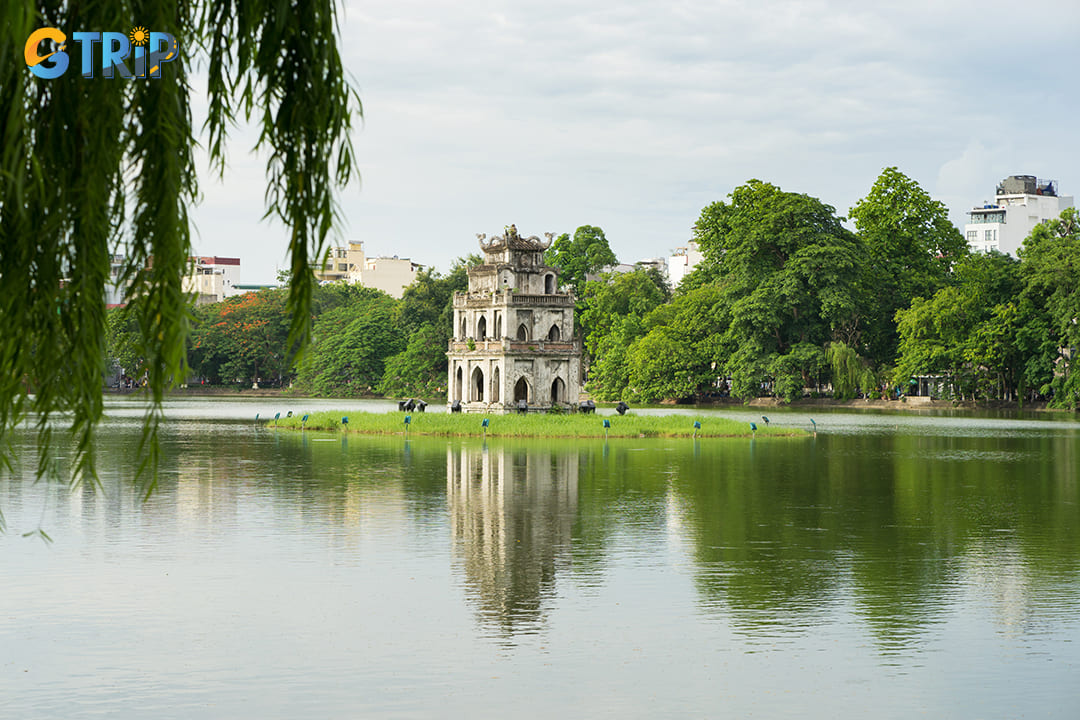
If you're already exploring Hanoi's Old Quarter or Hoan Kiem Lake, walking to the Temple of Literature can be a delightful way
4. By bicycle or motorbike
Bicycle
- Rental shops: Available in the Old Quarter, with rental prices ranging from 50,000 - 100,000 VND (approx. $2 - $4) per day
- Cycling path: Moderate traffic, recommended only for experienced cyclists
- Parking: Bicycle parking is available near the temple's entrance for a small fee (2,000 - 5,000 VND)
Motorbike
- Rental: Approximately 100,000 - 150,000 VND (approx. $4 - $6) per day
- License requirement: An international driving permit (IDP) or a Vietnamese driving license is recommended
- Traffic tips: Hanoi’s traffic can be challenging for first-timers. Ensure you have adequate travel insurance if renting
Reaching the Temple of Literature is accessible for travelers of all preferences. With proper planning, your visit to this iconic historical site will be smooth and enjoyable, allowing you to fully appreciate its rich cultural heritage.
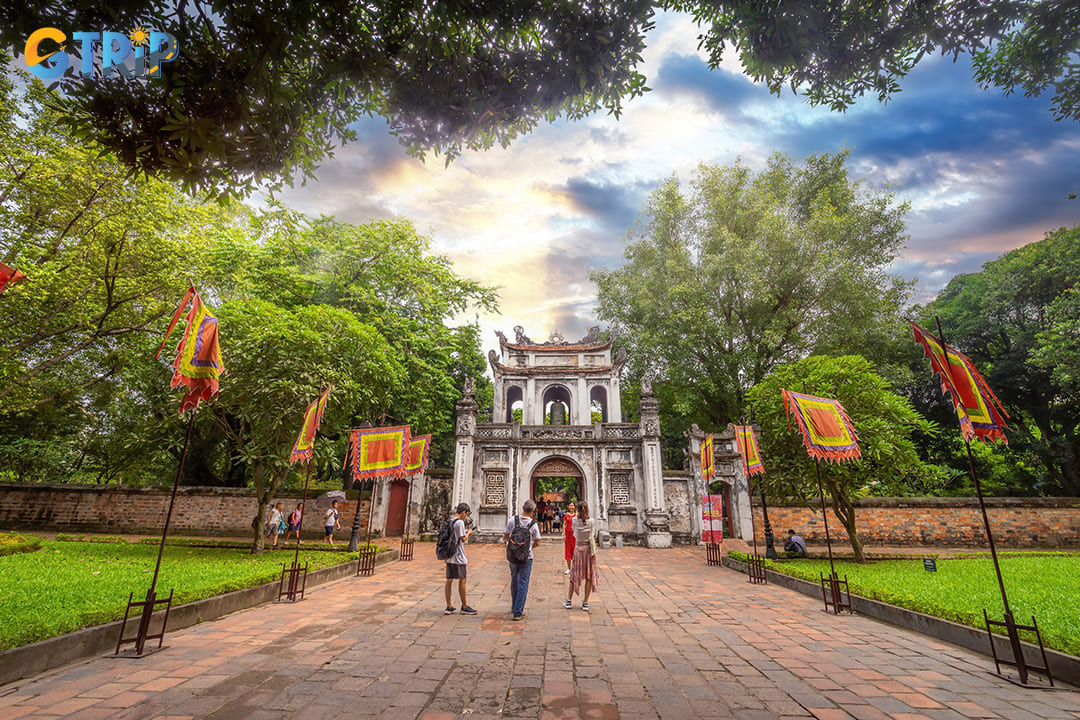
Reaching the Temple of Literature is accessible for travelers of all preferences
Read more:
History & Evolution of the Temple of Literature
After establishing the overarching historical narrative of the Temple of Literature, the next section delves into the transformative milestones that have defined its evolution.
Foundation in 1070: The birth of a cultural icon
The Temple of Literature was established in 1070 under the reign of Emperor Ly Thanh Tong. Its initial purpose was to honor Confucius, the great Chinese philosopher whose teachings shaped East Asian thought and values for centuries. Beyond serving as a place of worship, the temple symbolized the state's commitment to education and intellectualism. In its early years, it was primarily a site for the aristocracy, designed to foster a generation of morally upright and scholarly elites who would serve the royal court.
Establishment of the Imperial Academy (1076): The First National University
In 1076, under the rule of Emperor Ly Nhan Tong, the Imperial Academy (Quoc Tu Giam) was established within the temple's grounds. This institution became Vietnam's first national university, dedicated to educating members of the royal family and the country's elite. Initially reserved for the aristocracy, the academy gradually opened its doors to talented commoners, symbolizing a meritocratic shift in the pursuit of knowledge.
The curriculum focused heavily on Confucian texts, including the Four Books and Five Classics. These texts shaped the intellectual framework of the time, emphasizing moral integrity, filial piety, and loyalty to the sovereign. Students faced a rigorous education system that combined memorization, interpretation, and application of classical Confucian principles.
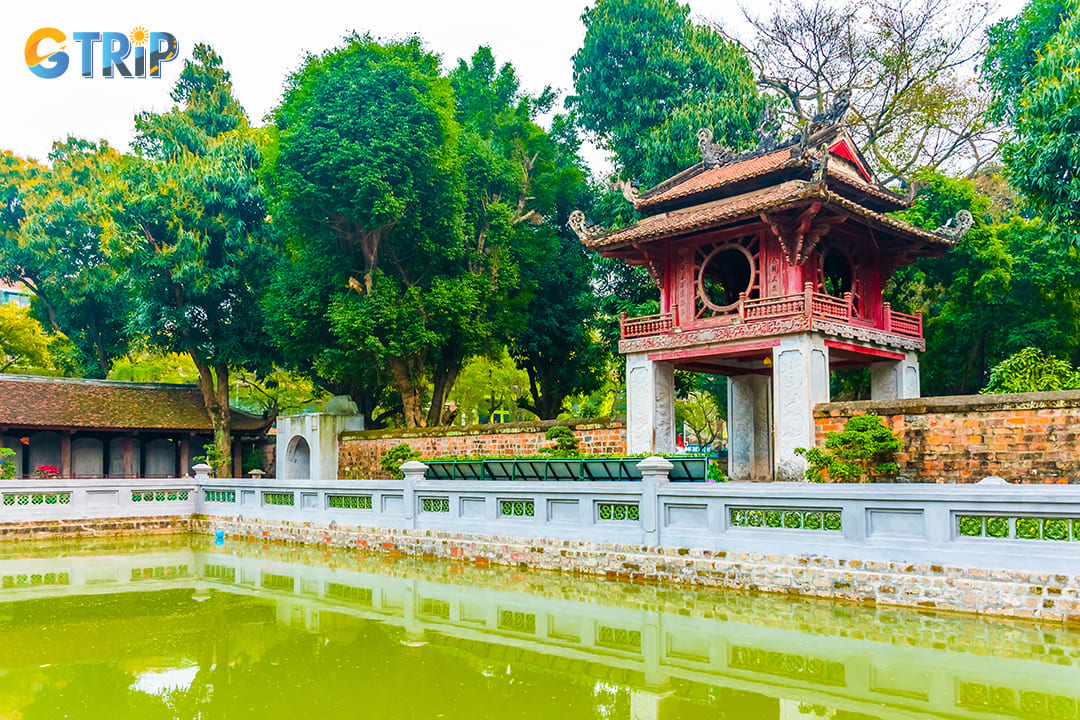
This institution became Vietnam's first national university, dedicated to educating members of the royal family and the country's elite
Dynastic influence and transformations: Ly, Tran, Le, and Nguyen Dynasties
The temple and academy experienced significant transformations across four major dynasties:
- Ly Dynasty (1009 - 1225): The foundation period focused on establishing the temple as a sacred Confucian site and an academic institution.
- Tran Dynasty (1225 - 1400): Despite political upheavals and Mongol invasions, the academy maintained its role in producing scholars for the imperial court. During this time, the examination system began to take a more formalized structure.
- Le Dynasty (1428 - 1789): The Le Thanh Tong era marked the golden age of Confucian scholarship in Vietnam. In 1484, the emperor ordered the construction of the stone steles to record the names of successful doctoral laureates, creating an enduring record of intellectual achievement. There are currently 82 steles resting on the back of each stone turtle, inscribed with the names of 1,307 scholars who passed the rigorous exams.
- Nguyen Dynasty (1802 - 1945): As the capital moved to Hue, the Imperial Academy was relocated. However, the Temple of Literature continued to serve as a cultural and educational symbol. The Nguyen emperors occasionally restored and expanded the complex, ensuring its preservation as a historic monument.
Restorations and renovations of heritage
Throughout its history, the Temple of Literature has undergone numerous restorations due to damage caused by wars and natural wear. Major renovations occurred during the Le and Nguyen Dynasties, reflecting efforts to maintain the site's historical and cultural significance.
In 2010, 82 stone steles were recognized by UNESCO's Memory of the World Register, a testament to their global cultural value. This recognition has led to increased efforts in conservation and restoration, ensuring the temple remains a vital symbol of Vietnamese intellectual and cultural heritage.
Today, the Temple of Literature serves as a historical site and also as a significant cultural symbol. It attracts both tourists and locals who seek to connect with the intellectual roots of Vietnam. The temple is also a site for honoring scholars during the annual Confucius anniversary celebrations and other cultural events.
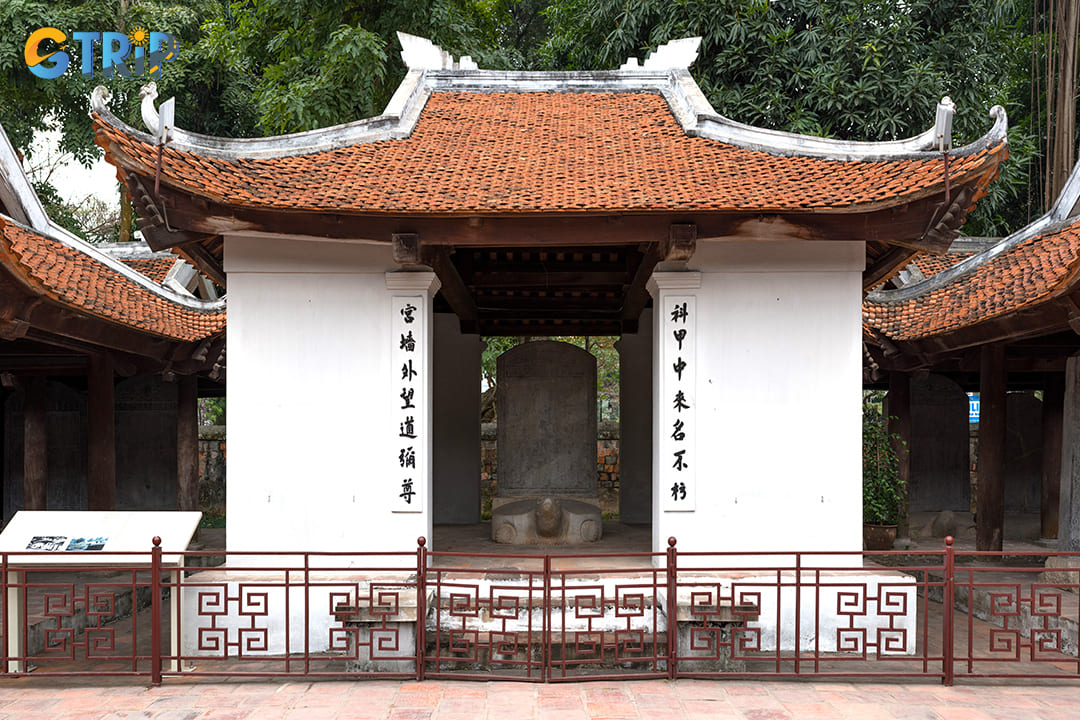
The stone steles were recognized by UNESCO's Memory of the World Register
6 Things to see when visiting the Temple of Literature
The Temple of Literature is organized into five distinct courtyards, each meticulously designed to embody different facets of Vietnam’s rich academic and cultural heritage. Exploring these courtyards offers you a comprehensive view of the temple’s historical and symbolic significance.
1. First courtyard: The Great Gate of Wisdom
Upon arrival at the Temple of Literature, you are welcomed by the Great Gate of Wisdom (Van Mieu Mon), an imposing entrance symbolizing the pursuit of knowledge. Beyond the gate, lush gardens and stone pathways create a tranquil setting, inviting tourists on a journey of intellectual and cultural exploration. It features three doorways and two levels, with the upper level inscribed with the ancient Chinese character "Van Mieu Mon". In front of the gate stand two stone steles on either side and a four-pillar ceremonial gate at the center. The gate exudes an aura of grandeur and solemnity, reflecting the temple's revered status.
Atop the Great Gate, which leads into the first courtyard, sits a fish figure steeped in legend. According to folklore, fish that leap over the strongest waves transform into mighty dragons, a metaphor for students striving through rigorous exams. This emblem serves as a timeless reminder of the dedication and perseverance required to achieve academic success.
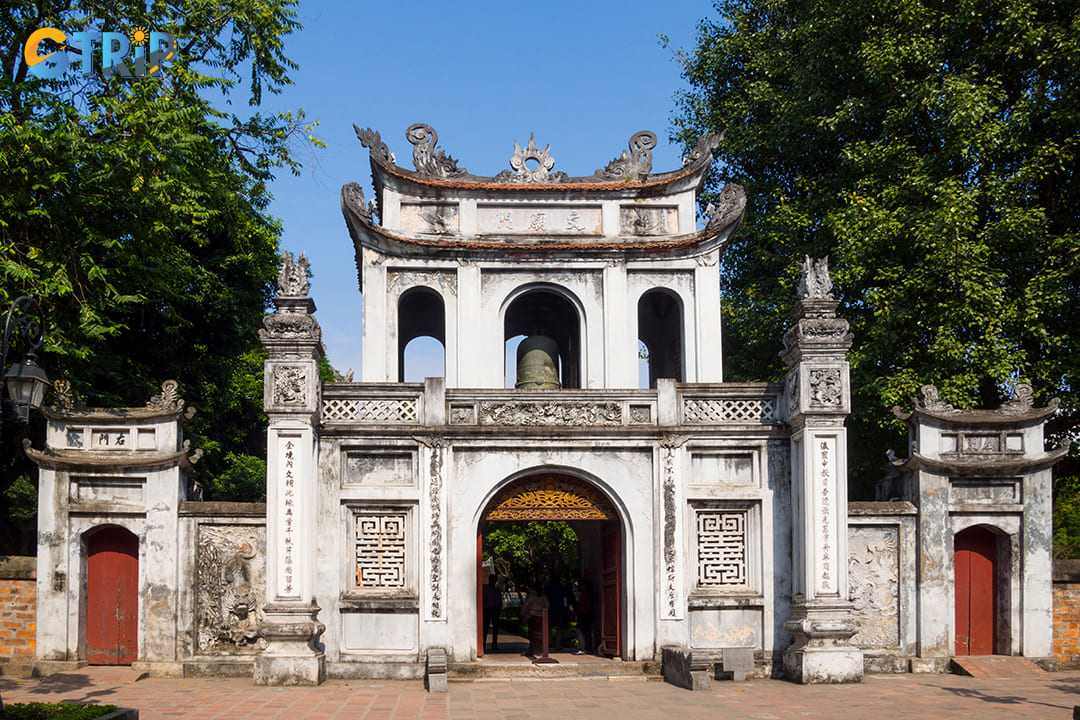
Upon arrival at the Temple of Literature, you are greeted by the grand Great Gate of Wisdom
2. Second courtyard: The Khue Van Pavilion
As you move deeper into the Temple of Literature, you’ll encounter the Khue Van Pavilion, an iconic structure built in 1805 during the Nguyen Dynasty. Designed as a square pavilion with a unique traditional layout, it stands as a powerful symbol of Vietnam’s literary and scholarly tradition.
The pavilion rests on a square platform, each side measuring approximately 6.8 meters, and rises nearly 9 meters high. The lower level is supported by four finely carved square brick pillars, while the upper level features a striking red wooden frame, gold-gilded details, and two tiers of red-tiled roofs. Its distinctive circular windows on all four sides resemble a radiant star, symbolizing brilliance in learning.
Historically, Khue Van Pavilion was a space where scholars gathered for poetry readings and literary discussions. Surrounded by peaceful gardens, it offers a serene atmosphere perfect for quiet reflection. Its refined architecture and cultural importance make it one of the most recognized landmarks of Hanoi and a lasting emblem of Vietnam’s dedication to education and the written word.
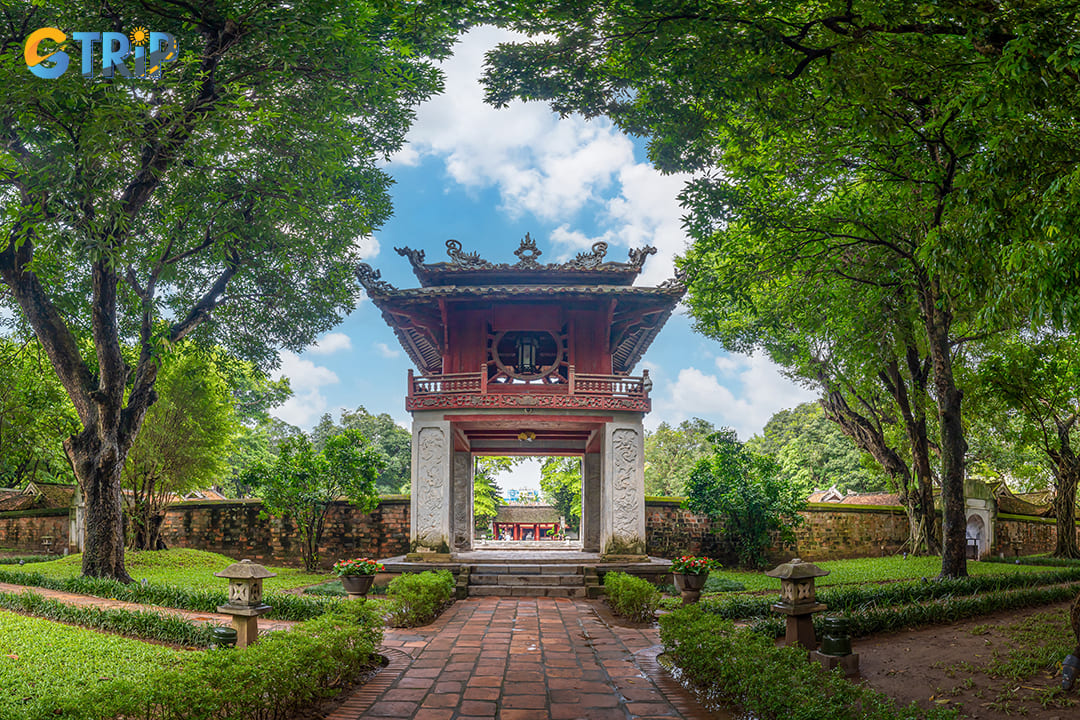
The pavilion’s striking red wooden frame, coupled with its distinctive circular windows, has made it one of the most recognized images of Hanoi
3. Third courtyard: The well of Heavenly Clarity and stelae of Doctors
The third courtyard is home to two of the most revered elements of the Temple of Literature: the Well of Heavenly Clarity (Thien Quang Well) and the Stelae of Doctors. The Well of Heavenly Clarity, a square-shaped pond at the center of the courtyard, symbolizes purity and intellectual enlightenment. It is believed that the well embodies the harmonious balance between the heavens and the earth, fostering an environment conducive to contemplation and learning. Surrounding the well are ancient trees and stone pathways that add to the peaceful ambiance.
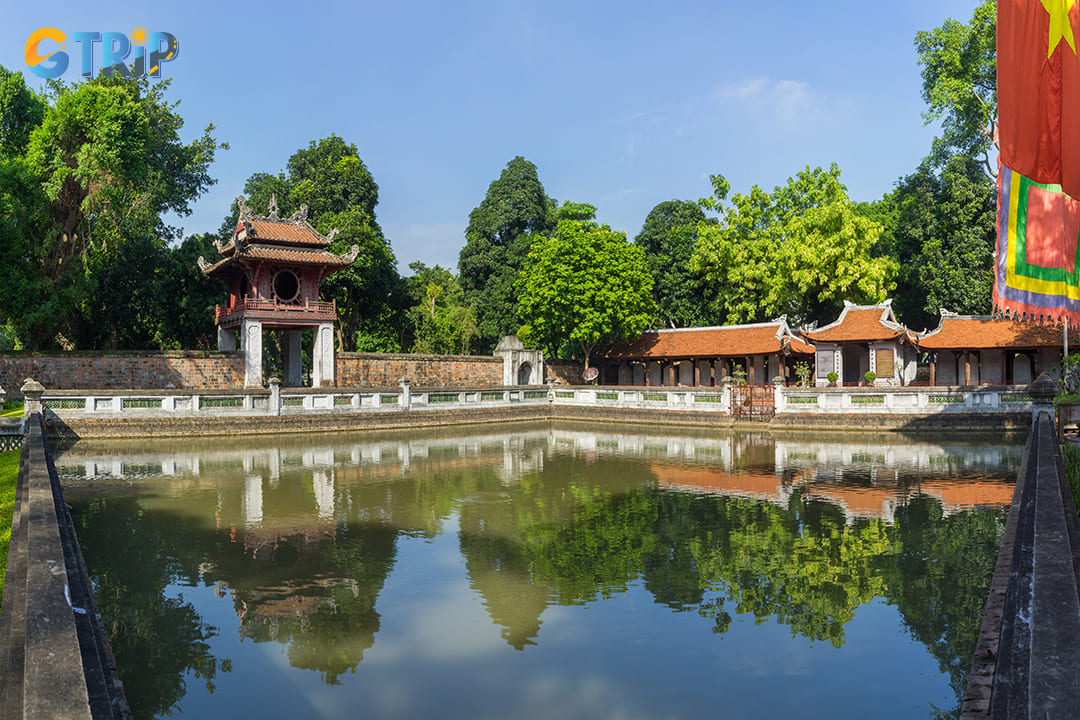
The third courtyard is home to two of the most revered elements of the Temple of Literature: the Well of Heavenly Clarity and the Stelae of Doctors
Next to the well, 82 stone stelae on sculpted turtles honor 1,307 scholars who passed the imperial exams from the 15th to 18th centuries. These stelae are significant records of Vietnam’s rigorous education system and are also revered as national treasures, earning recognition under UNESCO’s Memory of the World Program. The turtle, a revered symbol of wisdom and longevity in Vietnamese culture, reinforces the values of perseverance and knowledge. This courtyard is a solemn reminder of the nation’s deep respect for scholarly accomplishments and the enduring legacy of Vietnam’s intellectual elite.
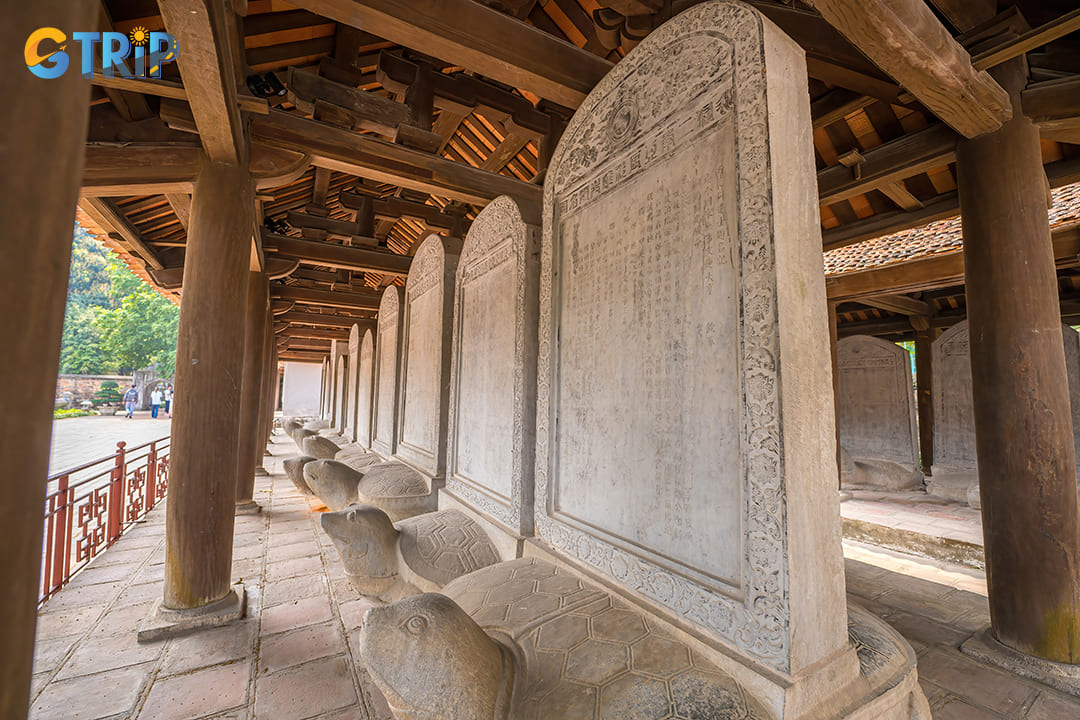
These stelae are significant records of Vietnam’s rigorous education system and are also revered as national treasures
4. Fourth courtyard: The House of Ceremonies
The fourth courtyard marks the transition from academic commemoration to spiritual reverence at the House of Ceremonies. This grand hall serves as a site for formal ceremonies that honor Confucius and distinguished scholars. Traditional rituals, often accompanied by offerings and incense, take place here, reinforcing the temple’s deep ties to Confucian philosophy. Architecturally, the House of Ceremonies is distinguished by its large bronze bell and drum, which were historically used to signal the commencement of scholarly gatherings and religious rites. The presence of these ceremonial artifacts underscores the temple’s dual function as both an educational institution and a sacred space dedicated to wisdom and moral virtue. By preserving these traditions, the fourth courtyard offers you an immersive experience of Vietnam’s enduring reverence for education and scholarly achievement.
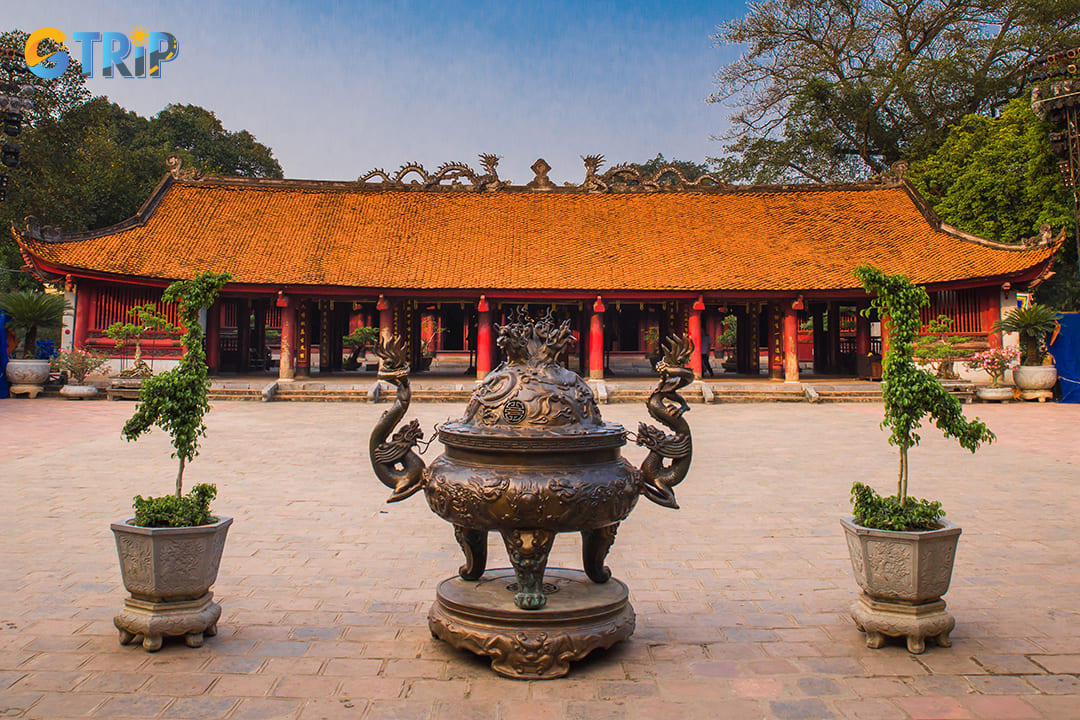
The fourth courtyard marks the transition from academic commemoration to spiritual reverence at the House of Ceremonies
5. Fifth courtyard: The Temple of Confucius and the Imperial Academy
At the far end of the site lies Khai Thanh Temple, dedicated to the worship of Confucius’s parents, Shuliang He and Lady Yan. In the past, Khai Thanh Temple also served as a residential complex with 150 rooms for students of the Imperial Academy. In 1946, the temple was completely destroyed during a French bombing raid. The Temple of Confucius, dedicated to Confucius and his four most esteemed disciples, serves as a place of worship and reflection. The altars within the temple are adorned with offerings and incense, paying tribute to the enduring influence of Confucian teachings on Vietnamese society. Architecturally, the temple integrates both Vietnamese and Chinese design elements, illustrating the cross-cultural transmission of Confucian ideals throughout history.
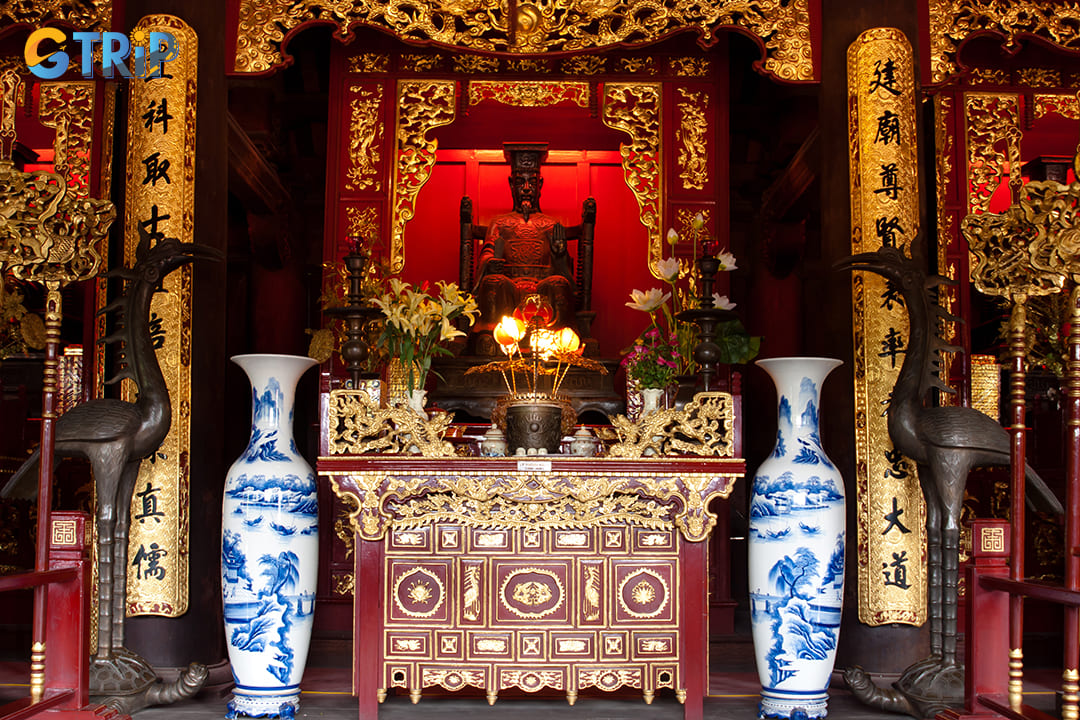
The Temple of Confucius, dedicated to Confucius and his four most esteemed disciples, serves as a place of worship and reflection
Beyond the temple, the remnants of the Imperial Academy offer insights into Vietnam’s prestigious educational traditions. Originally established to educate royal and aristocratic scholars, the academy played a pivotal role in shaping the nation’s intellectual development. Although it was relocated in 1802, its legacy endures through historical exhibits and informative displays that highlight the achievements of Vietnam’s most accomplished scholars. This final courtyard encapsulates the temple’s role as both a spiritual sanctuary and an academic institution, making it a cornerstone for understanding Vietnam’s educational and cultural heritage.
Each of the five courtyards within the Temple of Literature offers a unique perspective on Vietnam’s dedication to scholarship, tradition, and cultural identity. Together, they weave a narrative that honors the past while inspiring future generations to value knowledge and intellectual pursuit.
6. Temple of Literature night tour
The Temple of Literature Night Tour is a captivating cultural experience, offering you a unique way to explore this historic site under a mesmerizing display of lights and sounds. With a blend of traditional performances, innovative technology, and immersive storytelling, this tour brings Vietnam’s first national university to life like never before.
- Opening days: Every Wednesday, Saturday, and Sunday
- Opening hours tour: 6:30 PM - 9:30 PM
- Ticket prices tour:
- Adults: 199,000 VND (~ $7.62)
- Children (under 1m): 99,000 VND (~ $3.79), free if sharing a seat with an adult
Highlights of the experience:
Tourists will embark on a journey through key sections of the Temple of Literature, including Nhap Dao (Entrance), Thanh Dat (Success), Doctor’s Steles Garden, Dai Thanh (Great Success), and Thai Hoc (Higher Education). Each area is beautifully illuminated and accompanied by immersive sound effects, creating a breathtaking nighttime experience.
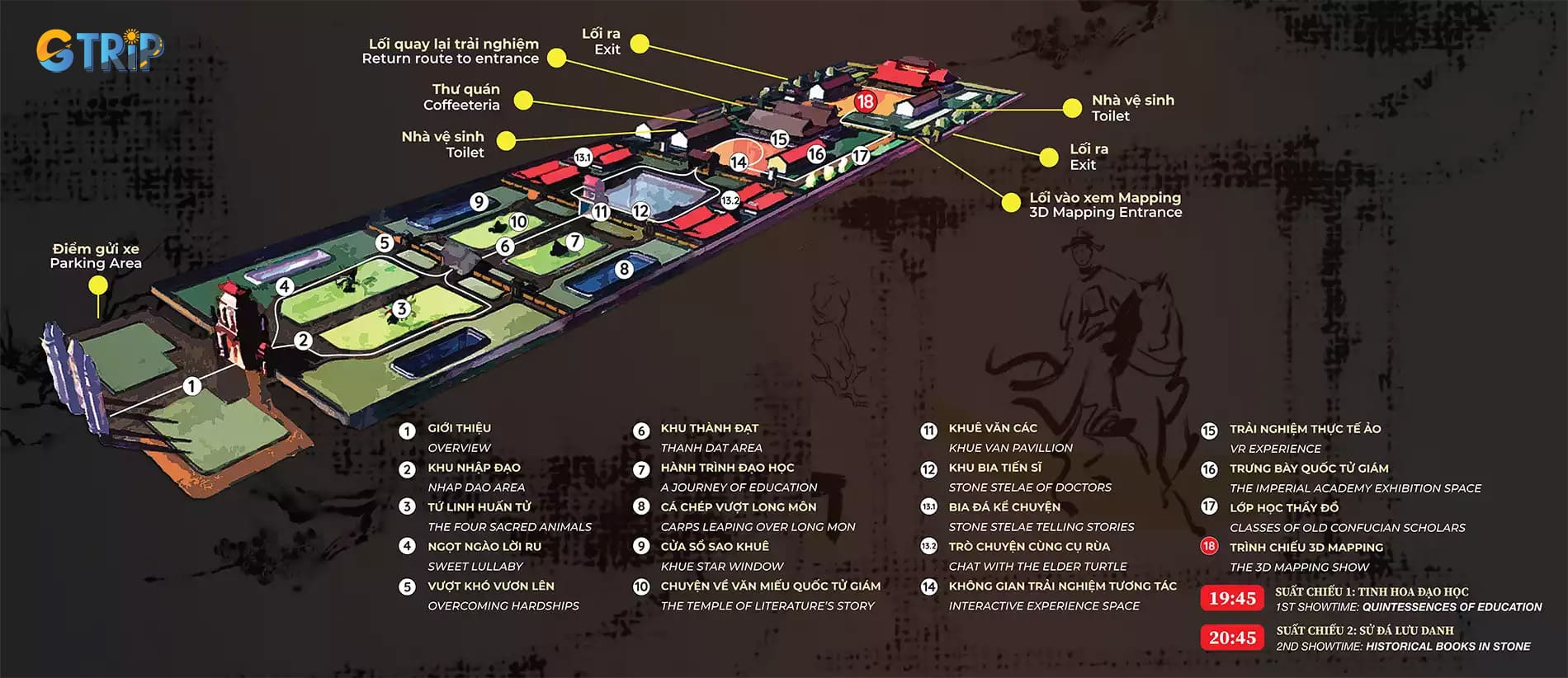
The map of the night tour at Temple of Literature
Traditional & Interactive activities
- Live performances: Enjoy captivating traditional Vietnamese art forms such as Xam singing, folk chants, and lion dance performances.
- Virtual reality in Dai Thanh Courtyard: Step into the past with an exciting VR experience, offering a new perspective on Vietnam’s first university.
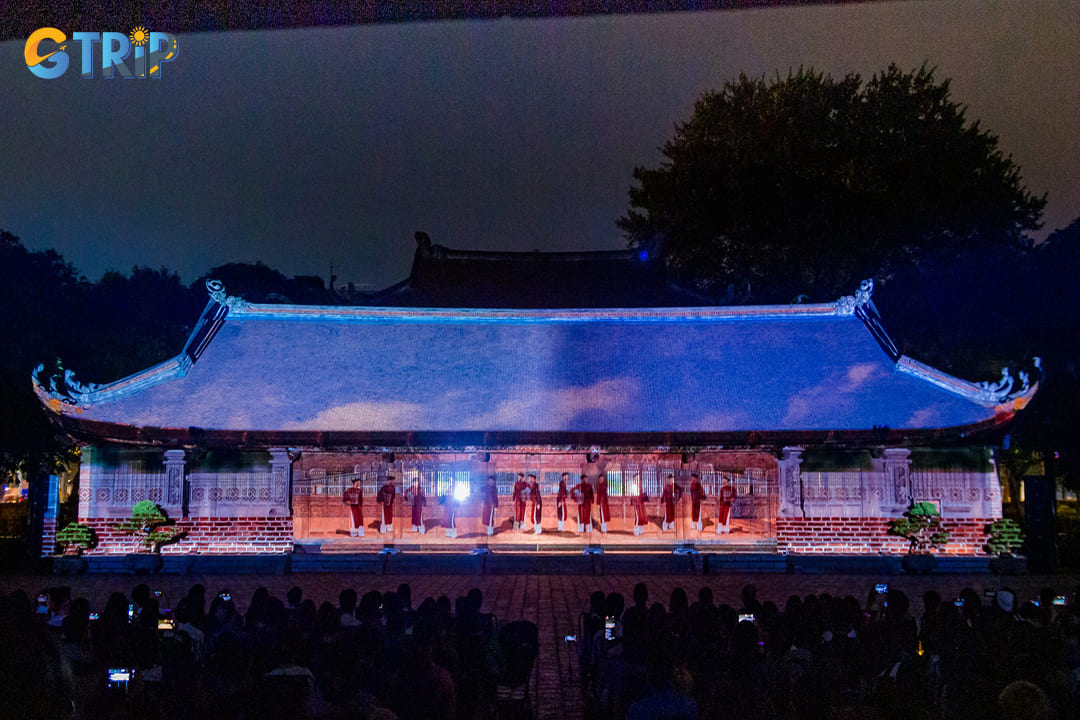
Tourists will embark on a journey through key sections of the Temple of Literature
3D mapping show: A visual masterpiece
A key highlight of the tour is the 3D mapping projection at the Thai Hoc Courtyard, where the facade of Tien Duong Hall transforms into a massive storytelling canvas. The program runs twice each night with two distinct themes:
- "Quintessences of Education" (7:45 PM): This performance highlights Vietnam’s deep-rooted tradition of learning and respect for teachers.
- "Historical Books in Stone" (8:45 PM): Follow the journey of a legendary turtle as it uncovers the wisdom inscribed on the Doctorate steles, the stone records of Vietnam’s educational and examination history.
Must-visit spots:
- Khue Van Cac (Khue Van Pavilion): A stunning setting for live traditional music performances.
- Bai Duong Courtyard: Discover an innovative virtual reality experience, offering a deeper connection to Vietnam’s historical heritage.
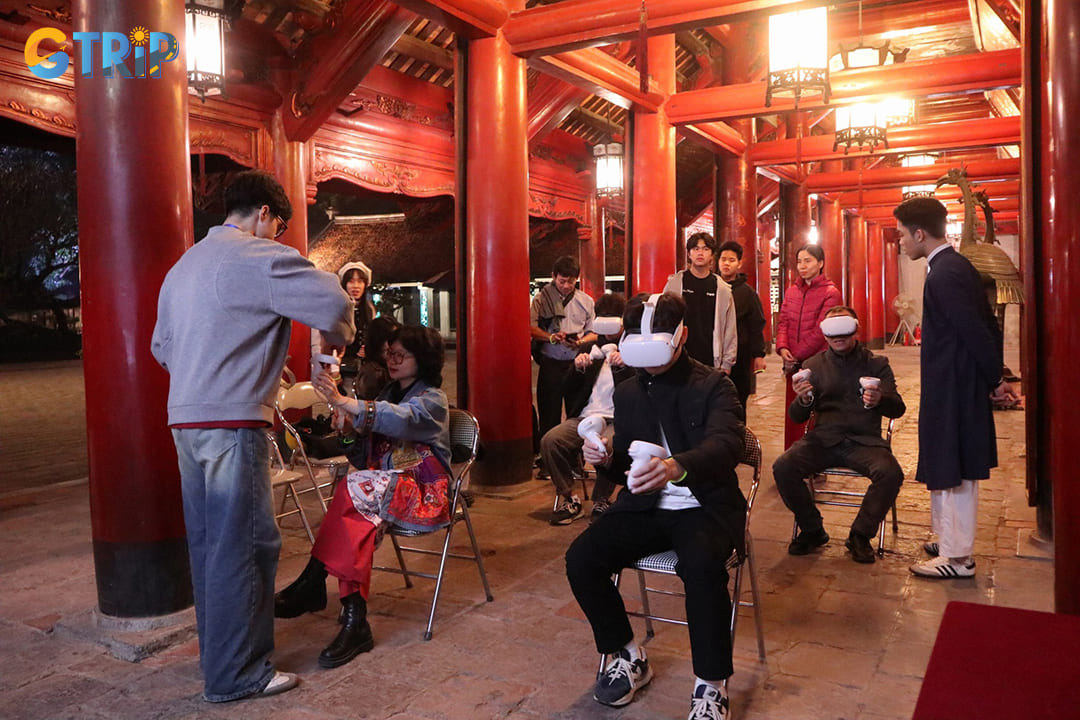
Step into the past with an exciting VR experience, offering a new perspective on Vietnam’s first university
The best times to visit the Temple of Literature during the day
Visiting the Temple of Literature in the early morning or late afternoon is ideal to experience its serene atmosphere while avoiding the midday crowds. The complex opens at 8:00 AM, and arriving right at the start allows you to enjoy the tranquility of the courtyards, especially before tour groups begin arriving. Late afternoons, around 3:30 PM to 5:00 PM, also offer a peaceful ambiance, with softer sunlight creating picturesque views for photography. Additionally, these times provide a respite from the intense midday heat, especially during Hanoi's summer months from May to August.
Seasonal events and local holidays can also influence the visiting experience. During the Lunar New Year (Tet), the temple becomes a popular spot for locals seeking blessings, creating a lively but crowded atmosphere. Similarly, examination periods for university entrance exams often see students visiting to seek academic luck. If you prefer a quieter experience, avoid these peak periods. Visiting on weekdays rather than weekends can also help ensure a more relaxed exploration.
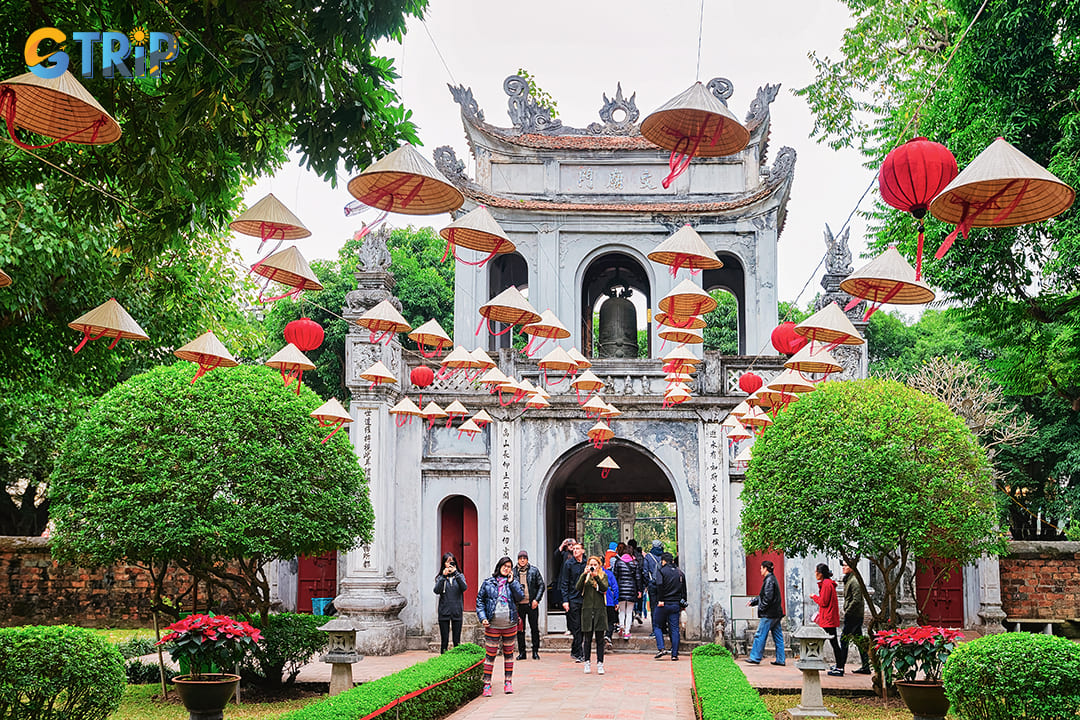
Seasonal events and local holidays can also influence the visiting experience
Nearby attractions from the Temple of Literature
Exploring the Temple of Literature opens up a gateway to several other fascinating landmarks in Hanoi. Each nearby attraction offers a unique glimpse into the city’s rich history and vibrant culture. By visiting these sites, travelers can gain a more holistic understanding of Hanoi’s heritage and how it interweaves with the intellectual legacy of the Temple of Literature.
Thang Long Imperial Citadel (1.3 km)
Just a few kilometers from the Temple of Literature, the Thang Long Imperial Citadel is a UNESCO World Heritage Site that narrates the evolution of Vietnamese political power. This ancient citadel provides insight into the governance and defense strategies of various dynasties, having served as the seat of power since the 11th century. It showcases layers of history, from early Ly Dynasty constructions to Nguyen Dynasty renovations, while ongoing excavations have unearthed artifacts and foundations that reveal the story of ancient Hanoi. The citadel’s preserved structures and formidable walls stand as a testament to Vietnam’s strategic importance and architectural ingenuity, making it a must-visit destination for history enthusiasts.
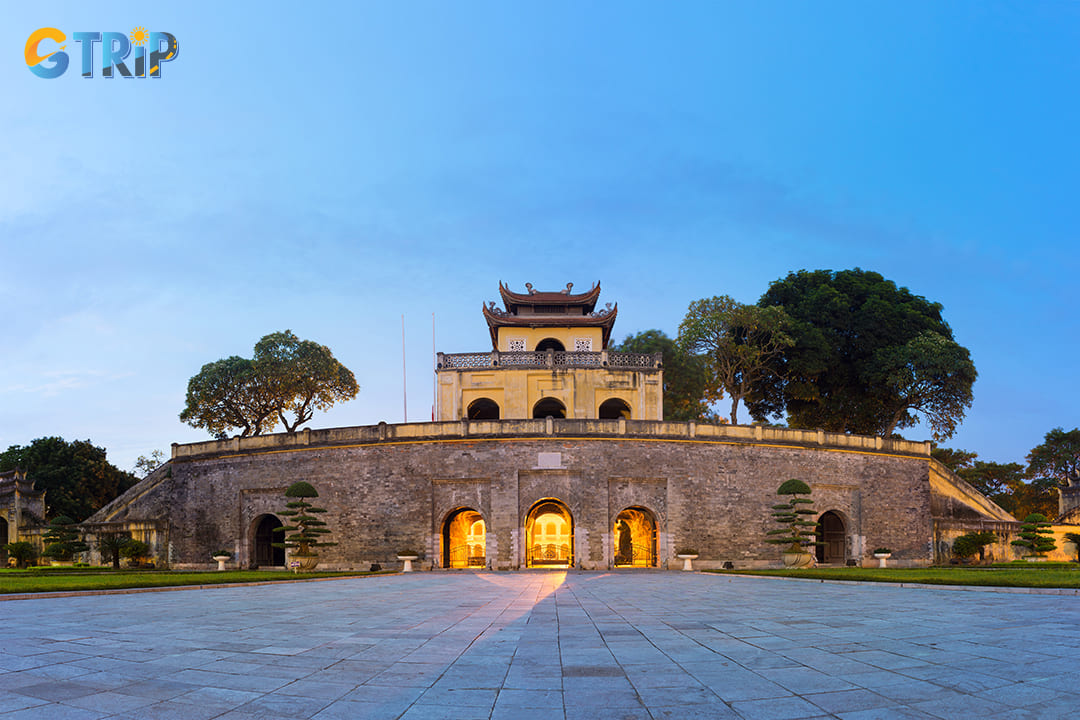
Thang Long Imperial Citadel is a UNESCO World Heritage Site that narrates the evolution of Vietnamese political power
Hanoi Old Quarter (2.8 km)
The vibrant and bustling Hanoi Old Quarter is a living tapestry of history, commerce, and urban culture, standing in stark contrast to the solemnity of the Temple of Literature. Its narrow streets, colonial architecture, and traditional shophouses preserve the essence of old Hanoi, with each street historically specializing in a particular trade such as silk or ceramics, a heritage still visible today. Beyond its historic charm, the Old Quarter is also a culinary haven where visitors can savor iconic dishes like pho, bun cha, and banh mi while immersing themselves in the everyday rhythm of local life, making it one of the most dynamic areas to experience Hanoi’s authentic spirit.
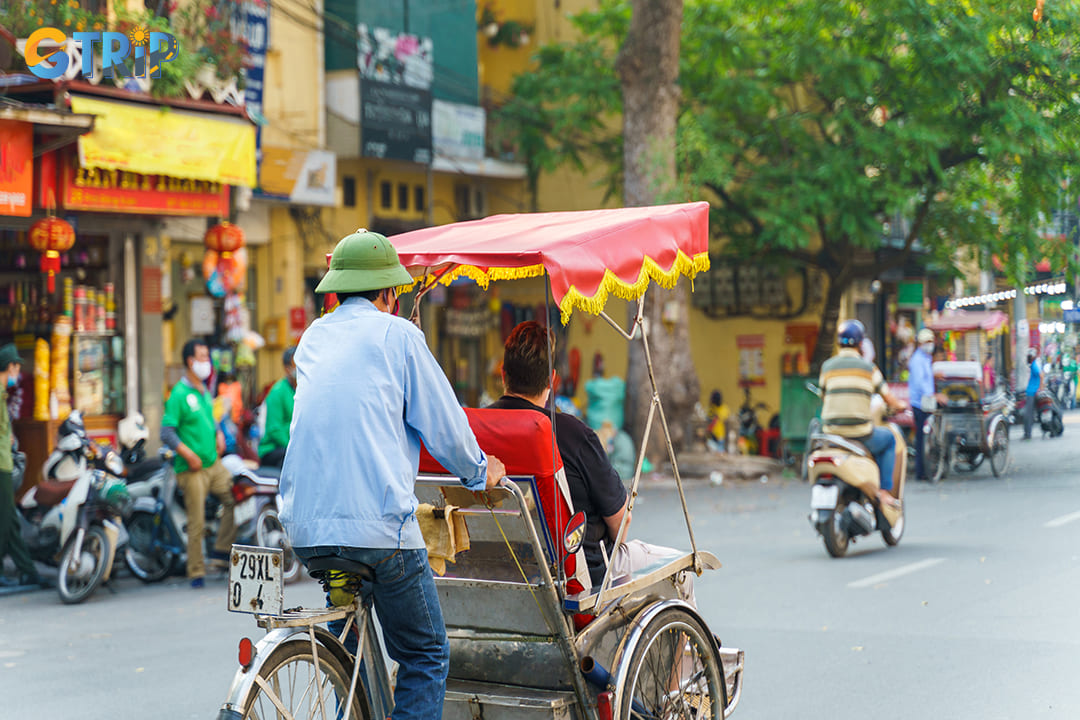
The vibrant and bustling Hanoi Old Quarter is a living tapestry of history, commerce, and urban culture
Hoan Kiem Lake (3.1 km)
Situated just a short walk from the Temple of Literature, Hoan Kiem Lake is one of Hanoi’s most beloved natural landmarks, steeped in legend and local lore, notably the story of the magical sword returned by a giant turtle. Beyond its scenic beauty, the lake and Ngoc Son Temple symbolize national pride and Hanoi’s storied past. Today, it remains a vibrant recreational hub, ideal for early morning strolls or peaceful evenings where locals gather to exercise and socialize. Visitors can also enjoy the surrounding cafes and street food stalls, making it a perfect spot to experience authentic Vietnamese flavors.
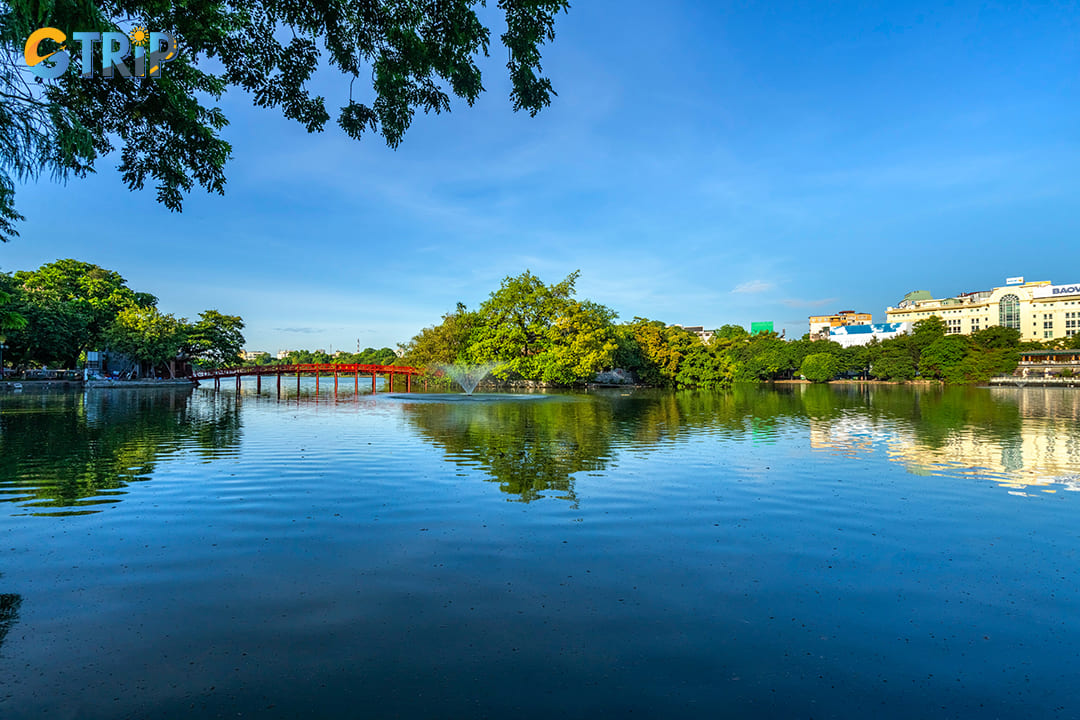
Situated just a short walk from the Temple of Literature, Hoan Kiem Lake is one of Hanoi’s most beloved natural landmarks
Vietnam Museum of Ethnology (4.9 km)
A short ride from the Temple of Literature, the Vietnam Museum of Ethnology is an essential stop for understanding the diverse cultures that shape Vietnam. The museum houses over 1,000 artifacts, ranging from traditional clothing and musical instruments to ritual objects, while interactive displays and multimedia presentations bring ancient customs to life. Beyond its extensive exhibits, the museum also runs educational programs, guided tours, and workshops that highlight how Vietnam’s 54 ethnic groups contribute to the nation’s cultural mosaic, offering visitors both knowledge and a more immersive experience.
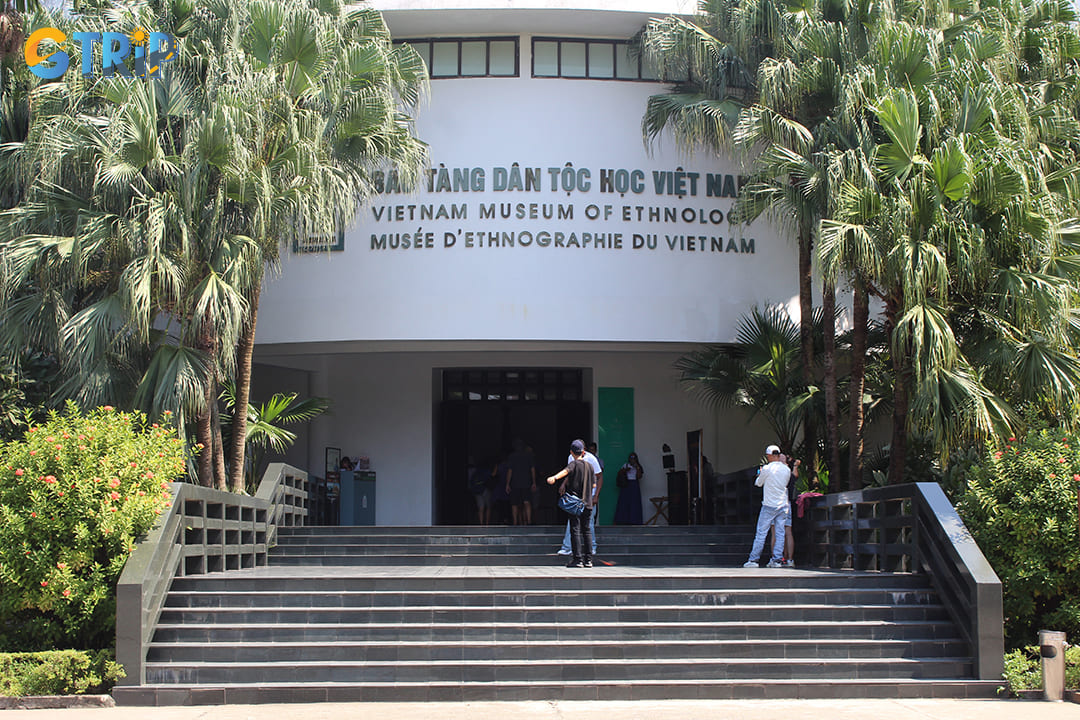
The Vietnam Museum of Ethnology is an essential destination for understanding the diverse cultures within Vietnam
Travel tips when visiting the Temple of Literature
- Respect the sacred space: Always refrain from touching the stone steles and turtles to preserve the site’s historical integrity.
- Dress modestly: Wear clothing that covers your shoulders and knees to align with local cultural norms.
- Avoid peak crowds: Plan your visit during early mornings or late afternoons to enjoy a more peaceful experience.
- Prepare for security protocols: Be ready to comply with any security checks or instructions from staff to ensure a smooth entry and exit.
- Consider guided tours: Joining a guided tour can provide valuable insights into the temple’s history and cultural significance.
- Engage with locals: Take the time to ask local staff or vendors about the legends and traditions associated with the temple.
- Practice discreet photography: Capture your memories respectfully by avoiding flash and staying mindful of sacred areas.
- Plan your itinerary: Research the temple and nearby attractions beforehand to allocate enough time for a relaxed and thorough visit.
- Bring a portable water bottle: Stay hydrated as you explore the expansive outdoor areas of the temple, especially during warmer days.
- Learn basic Vietnamese phrases: Knowing a few local expressions can enhance interactions with guides and vendors, making your experience more immersive.
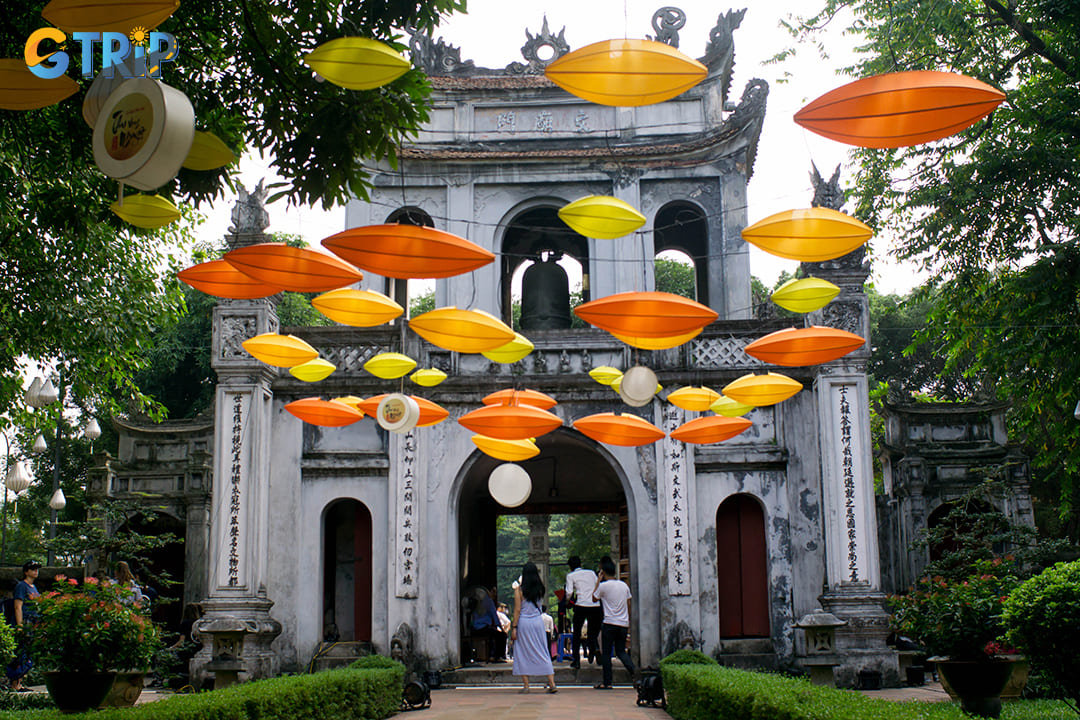
Remember travel tips before visiting the Temple of Literature
FAQs about the Temple of Literature
Each of these FAQs provides clear, expert-level insights that address common tourist concerns, enriching your overall travel experience.
What facilities are available for visitors on site?
The Temple of Literature offers basic facilities such as restrooms, seating areas, and small kiosks for drinks and snacks. Nearby vendors also sell traditional Vietnamese food for a quick bite.
Are guided tours available at the Temple of Literature?
Guided tours are available at the Temple of Literature through local travel agencies, where expert guides provide historical context, explain symbolic features, and enrich the overall visitor experience.
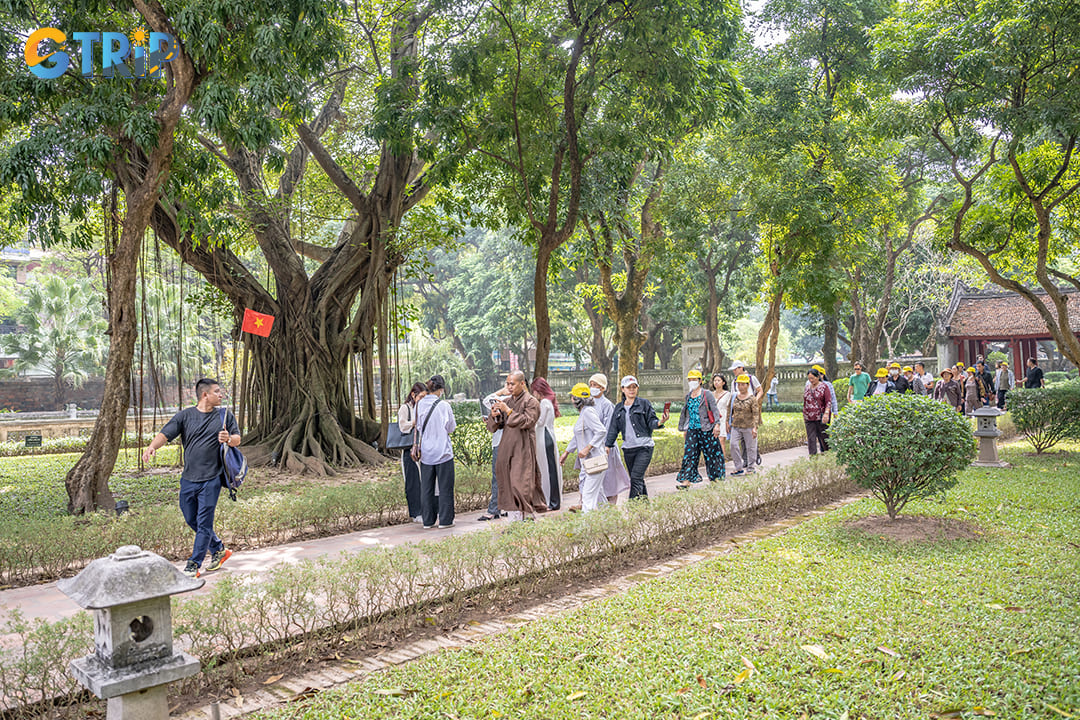
You can hire local tour guides from the travel agency
Is the Temple of Literature suitable for children?
Yes, the Temple of Literature is suitable for children, offering an educational experience about Vietnam’s academic traditions and Confucian values. While it’s a respectful and quiet site rather than an interactive attraction, guided tours and shorter visits can help keep kids engaged.
Can I bring food or drinks inside the Temple of Literature?
Food and drinks are not allowed inside the Temple of Literature, except for bottled water. Visitors should consume snacks outside the complex to help preserve the site’s respectful atmosphere.
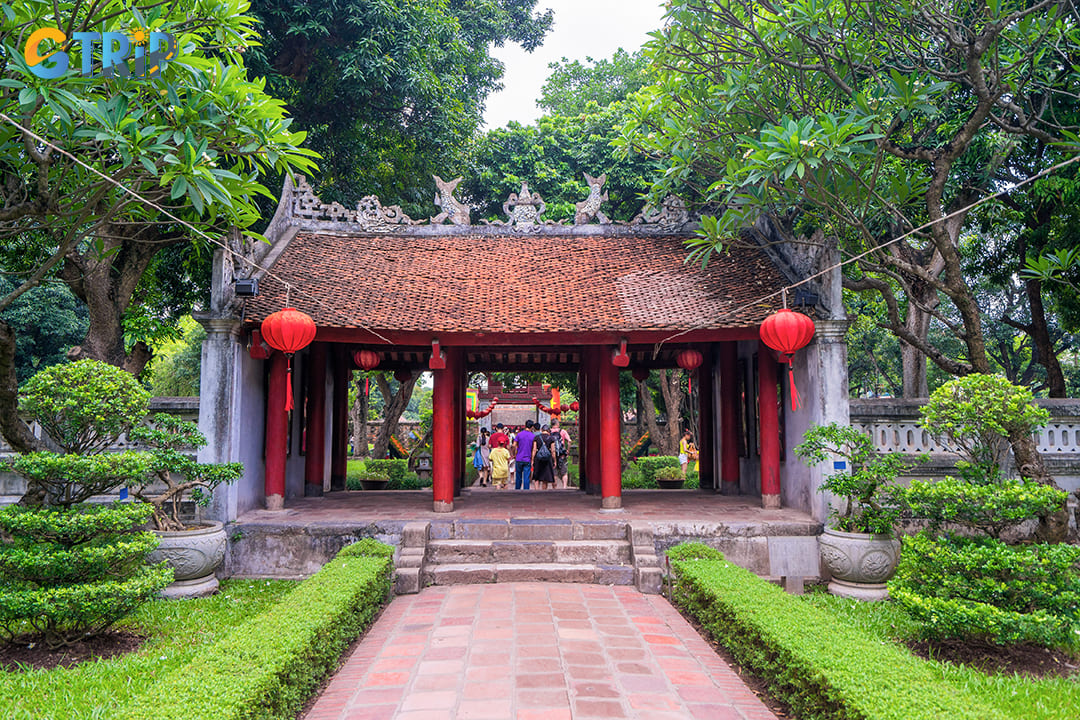
The Temple of Literature can be a meaningful educational experience for children
Read more:
The Temple of Literature is more than just a historical site, it’s a gateway to understanding Vietnam's intellectual and cultural heritage. Through this article, we've explored its architectural significance, historical roots, and the symbolic meaning that continues to resonate today. To make the most of your visit, consider exploring guided tours or learning about the traditions and rituals associated with this iconic landmark. If you're interested in diving deeper into Vietnamese culture or exploring more historical sites, explore more Hanoi Tours of GTrip - Vietnam Travel Agency.

